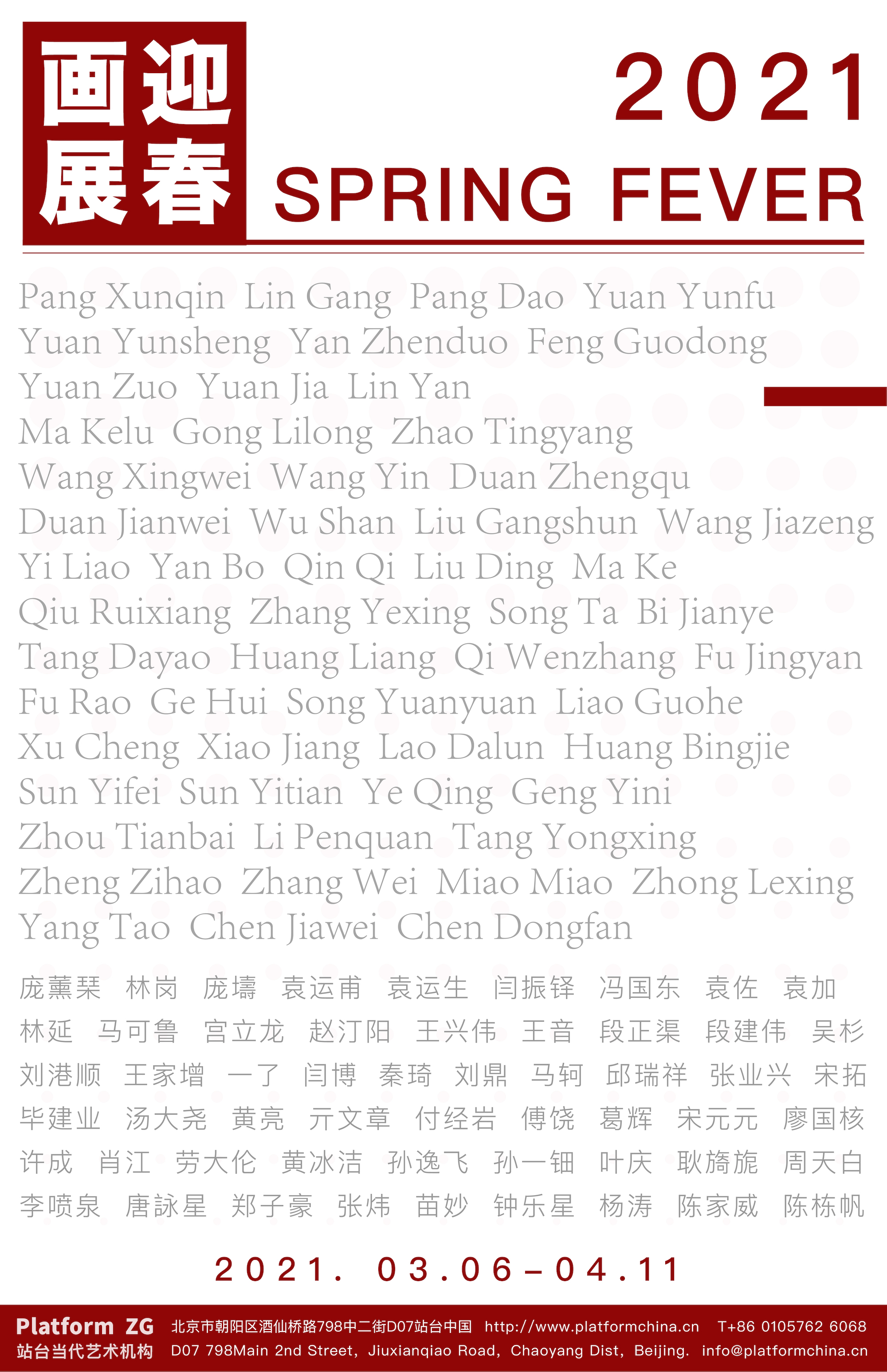
Opening
2021.03.06 3:00pm
Duration
2021.03.06 - 2021.04.11
Artists
Pang Xunqin, Lin Gang, Pang Dao, Yuan Yunfu, Yuan Yunsheng, Yan Zhenduo, Feng Guodong, Yuan Zuo, Yuan Jia, Lin Yan, Ma Kelu, Gong Lilong, Zhao Tingyang, Wang Xingwei, Wang Yin, Duan Zhengqu, Duan Jianwei, Wu Shan, Liu Gangshun, Wang Jiazeng, Yi Liao, Yan Bo, Qin Qi, Liu Ding, Ma Ke, Qiu Ruixiang, Zhang Yexing, Song Ta, Bi Jianye, Tang Dayao, Huang Liang, Qi Wenzhang, Fu Jingyan, Fu Rao, Ge Hui, Song Yuanyuan, Liao Guohe, Xu Cheng, Xiao Jiang, Lao Dalun, Huang Bingjie, Sun Yifei, Sun Yitian, Ye Qing, Geng Yini, Zhou Tianbai, Li Penquan, Tang Yongxing, Zheng Zihao, Zhang Wei, Miao Miao, Zhong Lexing, Yang Tao, Chen Jiawei, Chen Dongfan
Curator Team
Wang Tianmo, Gao Yumeng, Yu Chang, Wang Jiang
Venue
Platform China Contemporary Art InstituteD07 Main 2nd Street, 798 Art District, Beijing
Preface
From March 6 to April 11, Platform China’s main space and dRoom will host the group exhibition “2021 Spring Fever”. Back to 1979, another group exhibition New Spring Painting Exhibition was held in the waterside pavilion at Beijing Zhongshan park. It was an exhibition organized by artists themselves, and the preface, written by Jiang Feng, was published on the journal Dushu in the same year, inaugurating the avant-garde of the new age. New Spring Painting Exhibition was a collective event. It confirms that the vitality of the spring comes from cohabitation, mutual exchanges, and echoes the duration of art’s vitality. This New Year, Platform China’s exhibition 2021 Spring Fever redoes the spring exhibition, inviting a few artists and their works from the 1979 New Spring Painting Exhibition as well as some contemporary Chinese artists. The exhibition begins with the paintings and archives from 1979 to reflect on the artistic practices in the past generations, presenting the artists’ choices and positions when faced with an increasingly flattening world. The first post-Covid-19 spring is an event. It recalls memories of gatherings. It is life emerging again after a long winter.
Welcoming the spring is a discourse quite familiar to all of us. Yet, its significations are still much too ambiguous and grand. We don’t know if welcoming the spring is simply an act as it is, or a parody. Probably, welcoming the spring is merely just to face the spring, to return the words to what they merely are, to their ontology if there is one. The degree-zero of words, however, escapes language perpetually. We strive to arrive at that space before significations but could only obtain interpretations and meanings. To welcome the spring, therefore, is neither symbolic nor its complete opposite. It is a performance, within which we face the perpetual doubts turned against interpretations but couldn’t help but falling back to symbols and meanings.
To welcome the spring is therefore a perpetual action. The duration of art resists the discontinuity of historical narratives. How to understand the choices we face in the past 40 years? What keeps changing is changing itself. At the end of the 20th century, Michael Hardt and Antonio Negri’s Empire[1] describes the birth of new sovereignty. The dialectics of globalization and localization collapse as hybridity keeps emerging. Yet, simply describing globalization as the emergence of hybridity still cannot describe where we really are. In other words, to use Bruno Latour’s words, “The modern Constitution has collapsed under its own weight.[2]” We are, therefore, sometimes no longer facing the framework of the “West” and the “East”. Rather, we are facing the void of its collapse. Likewise, we are no longer facing the temporality of modernity and its counterpart pre-modernity. Rather, what arises as the issue is how modernity as a constitutional framework (in terms of language, socio-economic, historical, and temporal) collapses. What painting responds to is not often these apparent debates. However, this does not mean that painting exists outside of debates, outside of change, outside of history. Painting dwells humbly on the limits of language and history. It does not celebrate itself. Yet, with the emergence of each wave of change, it enriches itself.
What is most important, however, is the wish for physical gatherings. Group exhibitions present the convergence of different artistic experiences. Therefore, group exhibition provides the chance to pause and reflect on our commonality as well as singularity. Historical depth indeed grants the exhibition a physical and temporal distance from the audience, but it does not hinder us from recognizing singularities within the scope of our common experience. In this exhibition, we encounter both interconnectedness as well as differences, which collectively contribute to the duration of art’s vitality---there are, in a word, differences as well as repetitions. Like what the rivers in spring often realistically and metaphorically signify, they keep moving but do not yet know where they are heading towards.
By Wang Tianmo
Feb.25